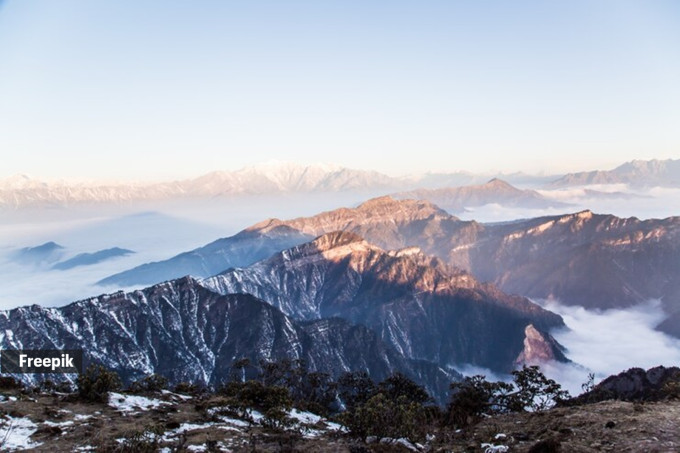Revealed: The reason planes avoid flying over the Tibetan plateau
The Tibetan plateau, with its towering mountains and vast, remote landscapes, is one of the most geographically challenging regions in the world. Despite its strategic location between major aviation routes, commercial aeroplanes almost universally avoid flying over this region.
The decision to steer clear of Tibetan airspace is not coincidental; it involves a combination of safety concerns, technical limitations, and environmental factors. Flying over Tibet presents unique challenges that set it apart from other high-altitude regions.

View this post on Instagram
A post shared by GeoGlobeTales (@geoglobe_tales)
R A Singh, retired joint director education department and geography expert, Ambedkar Nagar, Uttar Pradesh, tells indianexpress.com, “Flying over the Tibetan plateau, often called the ‘roof of the world,’ is a breathtaking experience, with stunning views of towering mountains and vast, untouched landscapes. However, for commercial airlines, the high-altitude terrain presents a unique set of challenges that make it a less-than-ideal flight path.”
So, what are these challenges?
Singh says, “The Tibetan plateau’s average elevation exceeds 4,500 metres (14,764 feet), and that thin air has some serious consequences for commercial aviation. Jet engines rely on oxygen for combustion. At high altitudes, the thinner air reduces the available oxygen, resulting in decreased engine power and thrust. This means aircraft must fly faster to generate enough lift, potentially increasing fuel consumption and limiting payload capacity.”
Thinner air also affects an aircraft’s ability to generate lift during takeoff and landing, he informs. This necessitates longer runways, which are often scarce in high-altitude regions like Tibet. “In the event of an in-flight emergency, such as engine failure or decompression, the options are limited in Tibet. The high altitude and rugged terrain make it difficult to find suitable landing sites, posing a significant risk to passengers and crew,” Singh adds.
Maintaining adequate cabin pressure is crucial at high altitudes to prevent hypoxia (oxygen deprivation). However, flying over the Tibetan plateau can put additional stress on the aircraft’s pressurisation system, increasing the potential for problems.
 While turbulence and challenging weather conditions can occur in any high-altitude area, the unique combination of extreme altitude (Source: Freepik)
While turbulence and challenging weather conditions can occur in any high-altitude area, the unique combination of extreme altitude (Source: Freepik)
The scarcity of landing options: A major deterrent
One of the most significant reasons airlines avoid Tibetan airspace is the lack of suitable emergency landing sites. In the event of an emergency, pilots need to be able to reach a safe landing area quickly. The vast, sparsely populated, and mountainous terrain of Tibet makes this a challenge, according to Singh.
He continues, “While there are a few airports in the region, they are often located in remote areas with limited facilities and infrastructure. Additionally, the high altitude of these airports can further complicate emergency landings, requiring specialised training and aircraft capabilities.
For airlines, the risk of being unable to safely land in an emergency outweighs the potential benefits of flying over Tibet, leading them to choose alternative routes that offer more options in case of unforeseen events.”
Turbulence and unpredictable weather
The unique topography and weather patterns of the Tibetan plateau create additional challenges for aviation. As winds flow over the mountains, Singh says, they can create powerful waves of air known as mountain waves. “These waves can cause severe turbulence, making for an uncomfortable and potentially dangerous flight experience.”
He adds that the high altitude and harsh climate of Tibet can lead to rapid weather changes, including sudden snowstorms, strong winds, and icing conditions. These unpredictable conditions can make flying challenging and increase the risk of accidents.
“While turbulence and challenging weather conditions can occur in any high-altitude area, the unique combination of extreme altitude, rugged terrain, and unpredictable weather in Tibet makes it a particularly demanding environment for aviation,” he notes.
Could advancements in aviation technology change the current stance on avoiding Tibetan airspace?
Advancements in aviation technology might make flying over Tibet more feasible in the future. Singh shares a few potential developments:
-Engine Advancements: More powerful and fuel-efficient engines could allow aircraft to operate more effectively at high altitudes, reducing the impact of thin air on performance.
-Improved Navigation and Communication Systems: Enhanced navigation and communication systems could make it easier to navigate the challenging terrain and weather conditions in Tibet.
-Enhanced Safety Features: Advancements in aircraft design and safety systems could improve the chances of a safe landing in an emergency, even in remote areas.
📣 For more lifestyle news, click here to join our WhatsApp Channel and also follow us on Instagram
Disclaimer: The copyright of this article belongs to the original author. Reposting this article is solely for the purpose of information dissemination and does not constitute any investment advice. If there is any infringement, please contact us immediately. We will make corrections or deletions as necessary. Thank you.
